Speech The Economic Outlook

Glenn Stevens
Deputy Governor
Address to 2003 CEDA Economic and Political Overview
Perth –
I must begin by thanking CEDA for the invitation to join this conference, and saying how pleasant it is to be back in Perth. In addition, I would like to express our thanks to the many people here who have assisted members of our staff based here in their efforts to understand the local and national economic scene. We appreciate very much the time you have offered.
I am told that many of the people with whom our economists have had recent discussions about the outlook are reasonably positive. The resource sector, which of course is quite important in Western Australia, has a fair bit of investment planned. But I will not speak in any detail about the Western Australian economy in particular, as there are others here who are probably better equipped to do that. My remarks will be mainly focussed on the international environment, and then the national economic scene.
Let me now spend a few minutes talking about the current conditions abroad, before turning to the issues which will be important in the year ahead. It is helpful that we are discussing this just a few days after the release of the Bank's most recent Statement on Monetary Policy, which covers recent events and the policy implications in great detail.
The World Economy in 2002 – A Promising Start but Disappointing Finish
A year ago, all eyes were on an apparent recovery in the US economy, which had experienced the mildest of recessions in 2001, and appeared to be in the early phase of a recovery, the strength of which was taking many people by surprise. Some of the more thoughtful observers wondered whether, given the particular nature of the recent business cycle, the weakness could all be over quite so quickly, but at the time the numbers coming in seemed to be lending support to a relatively optimistic prognosis. Hence, for several months during the first half of last year, talk of global recovery was in the air.
Unfortunately, this confidence waned during the second half of the year. To be sure, there has been continued expansion in the US economy, but it seems hesitant and unconvincing. Measures of consumer and business confidence declined, and share prices continued to drift lower, through the second half of 2002. Since the peak in early 2000, US share prices have fallen by around half. Close observers of the market point out that a fall over three successive calendar years had not occurred for over sixty years.
What is the essential characteristic of this episode? Everyone understands, I am sure, that during the second half of the 1990s, the United States (and many countries in Europe) experienced a period of extraordinary optimism about future returns to capital, particularly capital invested in information and communications technology. But while there is no doubt that such technology has powerful potential benefits for users, the big question has always been how many of the gains would be captured by the producers, as opposed to the consumers. The answer, apparently, on this occasion as in so many others in history, is: not much, certainly not as much as initially expected and not enough to validate all the investment, or valuations, which were a feature of the late 1990s.
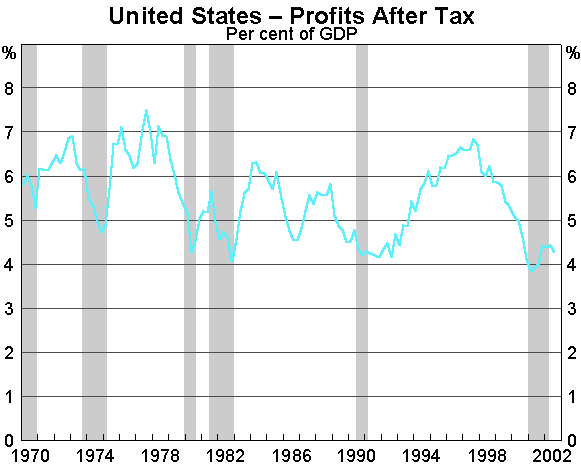
Remarkably, actual corporate profits in the US peaked in 1997 and declined thereafter, even as the valuations of expected future profits continued to rise until early 2000. It is not that surprising in retrospect that business capital spending in the United States subsequently slumped. Indeed, that single part of demand was responsible for putting the US economy into recession.
A key feature of the recovery to date, moreover, is that US companies in many sectors have still been struggling to deliver the profits that had apparently been expected, as implied by the earlier levels of share prices. Even now, share prices in the US appear to embody expectations of considerable earnings growth in the next few years.
All of this means that, in some important respects, the nature of this episode has been different to the normal business cycle events which characterised the second half of the twentieth century. The upswing of the 1990s did not end in a conventional acceleration of inflation and abrupt macroeconomic policy action to dampen those pressures. It ended with a period of corporate behaviour which, if anything, has probably created some deflationary pressures. The behaviour of households has been a stabilising force, keeping consumer demand rising (albeit more slowly than in earlier years), helped by the ability to access some of the very large accumulated wealth in the housing stock. In the short term, prospects for modest growth rest on that continuing until businesses are once again in a position to expand.
Hopes which might have been held that Europe would emerge as an independent source of growth impetus for the global economy have been disappointed. Europe is an economy as big as the US, but in many important respects its structural features seem to leave it much less likely to be a source of dynamism. The euro area followed the US economy into another period of weakness during the second half of 2002. Japan, too, has been unable to chart an independent growth path based on domestic demand. Such growth as it experienced in 2002 was export driven. That gave way to a renewed period of contraction towards the end of the year.
So across several fronts, the international environment, having looked as though it was improving noticeably early last year, turned out to be quite disappointing. The exception to this picture was in parts of Asia, particularly China, where growth has remained very strong in the past year. China is becoming a very significant source of supply for internationally traded manufactures, but also a source of demand for raw materials and various high-value services. These trends are already having quite noticeable effects on trade patterns, and will continue to do so for many years. Australia is as well placed as any country to benefit from this.
International Issues for 2003
The consensus of private forecasters calls for growth in the US economy of about 2.7 per cent in 2003. This is a forecast which envisages the ‘soft spot’ in late 2002 giving way to better growth in the early part of 2003. This helps to drive a forecast for world growth of about 3½ per cent, which is about the average growth over the past couple of decades.
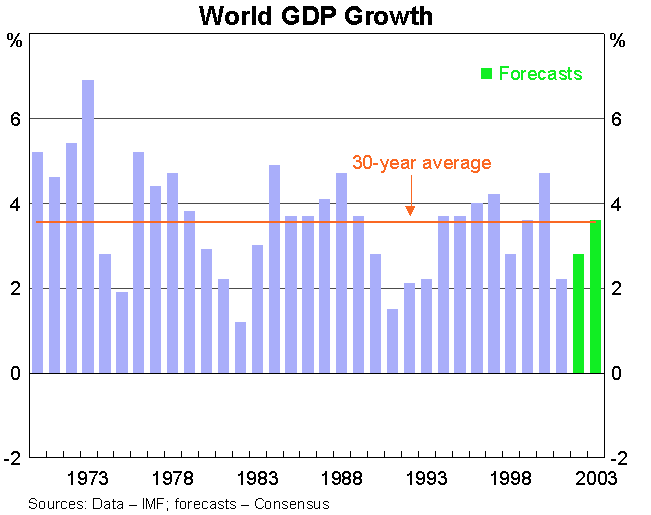
US economic policies are being altered in a way which will support the economy. For example, as we point out in our most recent Statement on Monetary Policy, the US government sector's financial balance swung towards deficit by about 4 per cent of GDP over the past two years and will continue in that direction in 2003. Some of this movement is the effect of the economy on the budget rather than actual measures taken, but discretionary budget measures have been quite substantial. In addition, US interest rates have fallen significantly, and are at their lowest levels in four decades.
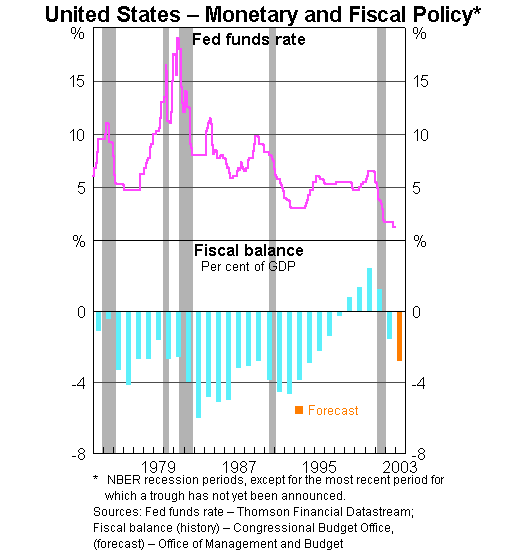
Contrary to what we hear in some quarters, macroeconomic policies are still effective. The likelihood is that the assistance being given by these policies will continue to support the US economy in the period ahead. The fact that the US financial system is not apparently seriously impaired by the fall-out in the financial markets is also a major bonus.
But getting over the legacy of the boom will still take some time. In the interim, of course, the US economy is more vulnerable to the effects of other adverse shocks which may come along than ideally we would like. So while it is sensible, in my view, to be an optimist about the US economy in the medium term, people are still a bit nervous about the path from here to that medium term. And, unfortunately, the global economy continues to be more dependent on US-led growth than is ideal, due to the chronic weakness of Japan and the apparent lack of dynamism in Europe.
One issue which I think could well come more sharply into focus this year is the value of the US dollar, which has come down in trade-weighted terms by about 12 per cent since the peak. The fall against the euro has been particularly noticeable – of the order of 25 per cent. Against the yen the fall has been much smaller. Substantial changes in exchange rates rarely occur without some controversy, because they always create winners and losers – so they can be uncomfortable for some. All countries concerned will have an interest in how exchange rate movements, especially among the big currencies, affect their economies, and I suspect we may see a good deal of discussion about this in the year ahead.
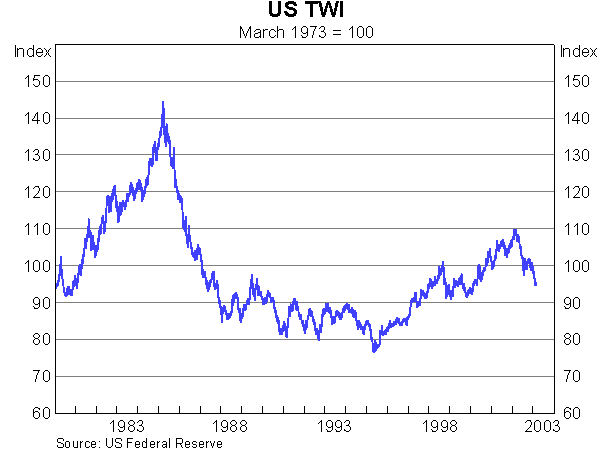
Then there is, of course, the mooted military campaign to disarm the Iraqi regime. Right now, this is probably the number one identifiable source of uncertainty cited by international decision-makers. Historically, wars have usually been expansionary and inflationary for the combatants. But I suppose at present the uncertainty may be less about the conflict itself and more about the nature of the world which might follow it, so that previous experience, including the Gulf War of 1991, may not provide a useful guide as to what to expect.
The world must have been an extremely uncertain place after World War II, or in the early 1950s with the Korean War and the apparent threat of confrontation at times between the nuclear powers during the Cold War. Yet this environment of geo-political tensions did not ultimately prevent the 1950s and 1960s from being a period in which prosperity increased fairly steadily in the Western industrial economies. So perhaps we should take care not to overstate these uncertainties. Underlying economic forces are still important. I venture to suggest that the continued rapid expansion of the Chinese economy will probably have a more profound impact on the world economy in the next ten years than a conflict with Iraq.
The Australian Economy
The above makes clear, I trust, that the international environment facing Australia has been far from favourable over the past couple of years. Yet economic growth has remained pretty strong, driven by domestic demand. This has been associated with a widening in the current account deficit, which is now receiving some attention, so it is worth spending a few minutes considering the arithmetic of trade performance. That arithmetic is set out in the table below. The figures incorporate estimates for the December quarter of 2002, based on partial data available.
After a strong recovery from the problems encountered in the Asian crisis, Australian exporters have generally found the going tough since about the middle of 2001. Between mid 2001 and the end of 2002, export volumes declined by about 2½ per cent. Remember that, on average, we expect exports to grow by about 7–8 per cent each year. So over the six quarters to the end of 2002, export volumes had fallen by some 12–13 per cent relative to the level they would have reached had they grown at trend rates. That's 3 per cent of GDP.
| Jun quarter 2001 – Dec quarter 2002 |
Annual average growth over 1990s |
Change relative to trend by Dec 2002 |
|
|---|---|---|---|
| Change in Exports | –2½ | 7.6 | –12½ |
| Change in Imports | 19 | 7.7 | 6½ |
| Real trade balance (per cent of GDP) |
–4.6 | ||
| Terms of trade | |||
| – per cent | 2.5 | ||
| – per cent of GDP | 0.7 | ||
| Trade balance (per cent of GDP) |
–3.9 | ||
| Current account balance (per cent of GDP) |
–3.8 | ||
Imports, on the other hand, have risen relatively rapidly, as domestic demand has risen at a pretty robust pace over the period in question. They rose by some 15 per cent, even before the effects of recent aircraft imports. To this we add the effects on investment spending of having one of the world's strongest and most profitable airlines, which is stepping up its capital-expansion program at a time when many of its rivals are struggling to survive. Including the aircraft, we find that in total, imports have risen above their trend to the tune of 1½ per cent of GDP.
The sum of the export and import effects gives us the change in the real trade balance – the drag on Australian GDP – over the six quarters in question. It has declined by 4½ per cent of GDP, with two-thirds of that on the export side, and the other third on the import side. In terms of income, as opposed to output, there is a slight offset in that Australia's terms of trade – the price of exports in terms of imports – has increased (which is unusual in a period of global weakness). This means that the decline in the current account balance, at 3¾ per cent of GDP, is a bit smaller than the decline in the real trade balance over the period in question. This is the basic arithmetic of how the current account deficit has widened from about 2 per cent of GDP in mid 2001 to a little under 6 per cent in late 2002.
No doubt we will hear much about the wider current account deficit in the year ahead. In thinking about this, it is worth remembering that the alternative to a temporary widening of the current account under the circumstances we faced would have been to slow down the Australian economy and our absorption of resources, in line with our lower income. After all, we cannot make the world's growth go faster, so if the current account were seen as a binding constraint, we would have had to slow down our own demand. That would have affected domestic production as well. No-one is seriously proposing that, and no other country would willingly do it (though some are on occasion forced to).
Of course, if the world turned out such that markets for our exports were permanently subdued, then Australians would have to adjust. We would have to temper our demand for resources from abroad, and work harder at making our products relatively more attractive to international markets. But there is no good reason to assume that that is the situation at present. Moreover, the capital inflow which is the counterpart of the current account deficit is willingly arriving, at interest rates which suit the Australian economy quite well. Hence, it is perfectly sensible to allow a temporary widening of this deficit, as the economy copes with the (hopefully short-lived) loss of foreign income. It is true that this can't be sustained indefinitely, but it doesn't have to be.

Indeed, this capacity to allow a temporary widening in the current account has helped the Australian economy to perform remarkably well in the face of two pretty disappointing years for the global economy. An acceleration of domestic demand has offset, so far, much of the weakening in foreign demand so that overall GDP growth has slowed only a little. Despite the weak world, and despite the pronounced slowing in several key service sectors of the economy, real GDP grew at an annualised pace of 3¼ per cent during the first three quarters of 2002, with the non-farm economy running a bit over 3½ per cent. The debilitating effects of drought on farmers and their surrounding regional communities will become more fully apparent in the next couple of quarterly figures, but overall the economy has turned in a very creditable performance.
What has driven this growth in domestic demand?
It has been a combination of ongoing expansion in consumer demand, high levels of investment in housing and the early phase of what will probably be a lengthy upward trend in business capital spending. For the household sector, as we spell out in our Statement on Monetary Policy, moderate rises have occurred in income, as employment has grown and wages have increased. Superimposed on this is a very large gain in the household sector's wealth over a run of years, due mainly to large rises in house prices. The stock of wealth is now about 7 times annual income for the household sector. So a rise in wealth of 11 per cent (the average rise per year since 1996) is the equivalent of about 75 per cent of a year's income. Only a tiny portion of that wealth is accessed – but even that tiny portion adds tangibly to the additional cash resources available to the household sector for other forms of investment or consumption. Over a number of years now, this has been an expansionary factor pushing along household spending in Australia.
| Level $ billion |
Share of total Per cent |
Annual Growth Per cent |
||
|---|---|---|---|---|
| Year to Sep 2002 | Average Sep 1996 – Sep 2001 | |||
| Housing | 2,085 | 62.4 | 21.9 | 12.2 |
| Consumer durables | 191 | 5.7 | 9.7 | 6.0 |
| Financial assets | 1,068 | 31.9 | 3.1 | 9.7 |
| – Superannuation and life offices | 506 | 15.1 | 0.0 | 11.5 |
| – Equities and unit trusts | 221 | 6.6 | 2.5 | 13.6 |
| – Currency and deposits | 303 | 9.1 | 10.9 | 6.6 |
| – Other | 38 | 1.1 | −7.5 | −2.6 |
| Total | 3,344 | 100.0 | 14.5 | 10.9 |
|
* Includes unincorporated sector. Sources: ABS, RBA |
||||
Associated with the increasing size of the household sector's assets has been a run up in debt. Indeed, the capacity to borrow to acquire assets or to borrow against assets for other purposes has been a necessary condition for this dynamic to operate, and that capacity has been fostered by the relatively low level of interest rates. There is a good deal of discussion as to how long this process can go on, and whether the household sector is becoming overly indebted and so on.
Relative to current income, debt has increased a lot; relative to the value of assets, debt has increased only modestly. Debt-servicing burdens have gradually increased, though they remain well below where they were in the period of very high interest rates in the 1980s. For the most part, our view has been that this general trend was to be expected in the circumstances of low nominal interest rates, greater access to financial products, and a starting point where Australian households had little debt by international standards. With one exception, we have not rushed to ring alarm bells about excessive debt. The exception is, of course, the rapid growth in debt to finance investment in rental properties, where we felt during 2002 that people were being drawn into a position of high leverage by unrealistic expectations of returns. At some stage down the track, this is likely to result in disappointment for many and distress for some – hence we had a duty to speak up.
More generally, however, there is a very large accumulation of wealth which remains, as yet, untapped. One of the important questions is to what extent households will be inclined to draw on this in the future. Many factors will be at work in determining the answer. For a start, how permanent is the wealth gain? The more confident people are that it is permanent, the more likely they are to draw on it. Demographic and distributional factors will also be important – who owns the assets and who owes the debts? I think we are only in the early stages of coming to an understanding of all these things, and there will be much discussion of them in the years ahead.
Then there is business investment activity, which as I noted earlier has been rising over the past year. Judging by the broad historical patterns, this has some way to run yet. Investment levels still seem a little lower than historical averages. Profits are strong, and new funding is readily available. Corporate balance sheets are strong. So conditions seem conducive to further investment increases, and indeed the available forward indicators point to further growth in the year ahead.
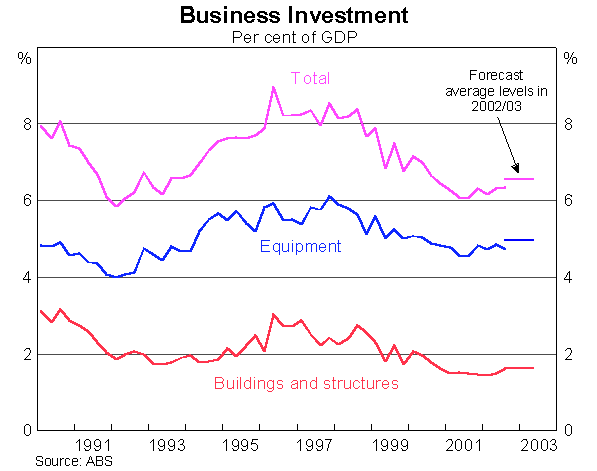
Conclusion
Australia still faces a difficult environment abroad. Uncertainty is high internationally at present, and confidence subdued. It is to our advantage that this appears to have affected Australians relatively little (indeed, it is comparatively rare to see Australians more confident in surveys than Americans) and this has helped Australia perform well. Nonetheless, global conditions have been a major drag on the economy over the past couple of years.
In the coming year, domestic demand in Australia will continue to grow, although probably more moderately than in the recent past. Most forecasters anticipate that the drag from abroad will begin to ease as the year goes on. If so, the net of those forces will mean that Australia will record overall growth a bit lower than we have seen most of the time in recent years, although still a pretty respectable outcome.
In the circumstances, I think that's about as good a result as we could sensibly hope to achieve. Provided that we remain relatively free of imbalances at home, we could then expect to benefit from better economic conditions abroad once the current adjustment phase gives way to greater optimism and expansion – even though we cannot be sure when that will be. A return to more normal weather patterns, which we all hope will occur, would also give a boost through the farm sector. Throughout that we all face challenges of various kinds, and I wish you well in meeting them.
Thank you.